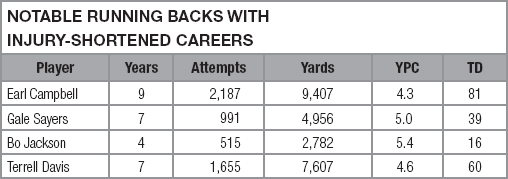
#20
EARL CAMPBELL
Most running backs don’t last very long in the NFL. The wear and tear of hard tackling and blocking seems to wear out running backs faster than players at any other position in the NFL. This even applies to the great backs in the game’s history. Jim Brown retired at the peak of his powers because he wanted to pursue a film career. But Earl Campbell, “The Tyler Rose,” left the game after eight seasons because his body simply had nothing left to give.
Campbell aficionados will remember that he spent his last two years with the New Orleans Saints. Those two years were basically about muscle memory and running on fumes under his former Houston Oilers head coach Bum Phillips. However, when Campbell was in his heyday during six glorious years with the Oilers, he was a combination wrecking ball, sprinter, and running machine.
Campbell’s style was all about hard work and inflicting punishment on those who attempted to tackle him. As a result, he wore out after a shorter stay in the NFL then he had planned. Nevertheless, he ranks with the all-time greats in the game’s history. Campbell was so strong and powerful that many NFL historians refer to him as strictly a power back. But while he did not have a lot of make-you-miss moves, Campbell also had fine straight-ahead speed and could outrace the defense once he got to the sidelines.
It’s hard not to think of the Monday night game against the Miami Dolphins during his 1978 rookie season when thinking of Campbell’s top moments. The Oilers beat an excellent Dolphins team that night, 35–30, as Campbell rushed for 199 yards and four touchdowns. The last of those was an 81-yard run down the far sidelines with Dolphins cornerback Curtis Johnson in pursuit. Johnson chased Campbell the last 30 yards of the run but he could not catch him.
“It was a wide running play,” said Phillips, “the pitchout. He started and turned up the field. About five people had an angle on him, and two of them were cornerbacks, and they couldn’t catch him. Earl never could get caught once he got out into the open.”
Phillips knew that Campbell had carried the Oilers to a big win that night and he also knew that Campbell was one yard short of gaining 200 yards. He asked his star if he wanted to go back in to pick up the yard and have a 200-yard night. Campbell, exhausted and sucking oxygen, thanked Phillips and told him to put backup Ronnie Coleman in the game.
Phillips was known as a coach who supported all of his player publicly, but his backing of Campbell knew no limits.
“He was a great back who dominated games with his talent and his heart,” Phillips said. “But there was a lot more to him than that. He was so good that he made the offensive linemen blocking for him appear better than they really were. He was so good that he made the quarterback look better than he was. He was so good that he made his coach look a lot smarter than he really was. You can’t ask for more from a player than that.”
Campbell led the NFL in rushing yards in each of his first three seasons. As a rookie he made his mark by rushing for 1,450 yards and 13 touchdowns while averaging 4.8 yards per carry. It didn’t stop there as Campbell was even better his next two seasons. He ran for 1,697 yards and 19 touchdowns his second year and an incredible 1,934 yards and 13 touchdowns while averaging 5.2 yards per carry in year three. That yardage total was the second-highest in NFL history at the time and was just 69 yards behind O. J. Simpson’s single-season record of 2,033 yards, set in 1973 (though in a 14-game schedule). Campbell was nearly unstoppable as he put four 200-yard rushing games on the board and continued to overpower defensive players with his bludgeoning forearms.
A two-time league MVP (1978, 1979), three-time offensive player of the year (1978–1980), and five-time All-Pro selection, Campbell’s great strength also led to his premature retirement from the game. He never ran out of bounds when he had the opportunity and he seemed to look for contact even if he could cut to the outside to avoid it.
Campbell’s overwhelming style won him the respect of the league’s best defensive team, the Pittsburgh Steelers. “I was never afraid to tackle anyone and I basically enjoyed it when I had the chance to stick someone,” said Steelers Hall of Fame defensive back Mel Blount. “But it was a different story with Campbell. That was a very dangerous man. He inflicted a lot of punishment and a lot of pain. I did what I could against him but it was always a chore and always difficult. Tackling him was like taking a punch from Joe Frazier.”
Campbell was still a pounding runner after the Oilers traded him to the Saints during the 1984 season but he didn’t have much cartilage left in his knees and his speed had all but disappeared. He ran for 643 yards and averaged 4.1 yards in his final year and had to hang it up, realizing that there was nothing left in the tank. His career was short and explosive and it’s doubtful fans will see its like again.

